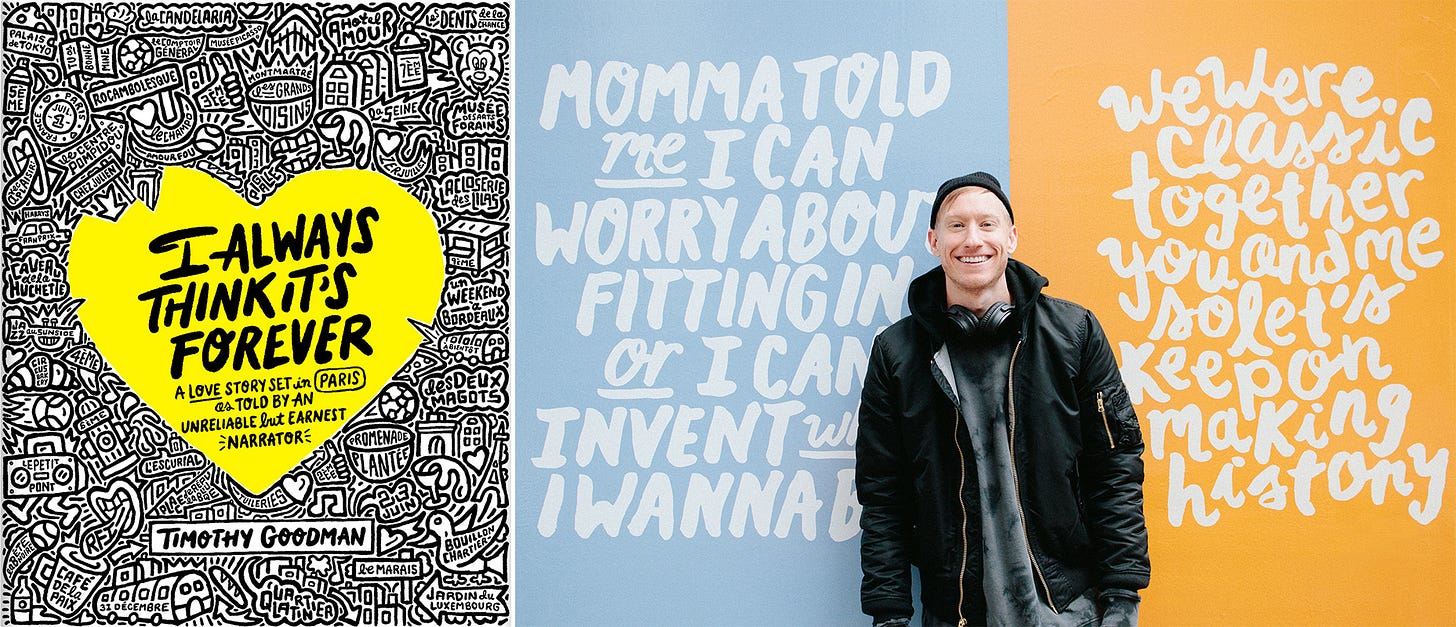Intro
“[L]ife is mostly spent putting ourselves back together. But hopefully in new & interesting ways. For me that is what the creative process is . . . the act of retelling the story of our lives so that it makes sense.”
—Nick Cave, Faith, Hope And Carnage
Last week I wrote about watching the Nick Cave movie, 20,000 Days On Earth, and how it had jump-started me creatively. I didn’t write about its most horrifying moment, but I’ll try to here. I’m following the words, not guiding them, so bear with me.
The movie’s a fictionalized version of Cave’s 20,000th day, and early on there’s an interview (or therapy session) with Darian Leader. After Cave talks about his rowdy and adventurous ‘free-range’ childhood in Australia, Leader asks him, “What do you fear the most?”
Cave pauses and contemplates the question for a while, before replying,
“My biggest fear is losing my memory. It does worry me at times that I’m not gonna be able to continue to do what I do, and reach a place that I’m satisfied with. Because memory is what we are. I think that your very soul and your very reason to be alive is tied up in memory.”
He weaves that into his narrative songwriting and world-building: “It’s a kind of world that’s created around those precious, original memories that define our lives.” Without memory, his songs and worlds would be lost.
And I found it the most horrifying thing in the movie because of what happens about two years after 20,000 Days On Earth comes out: the accidental death of one of his teenaged sons.
For the entire 10-second gap before he answered Leader’s question, I thought he was going to say his greatest fear was losing a child. It would’ve been an obvious — even safe — answer. I don’t even have kids and it would’ve been my answer! But instead it’s his memory — especially as it pertains to storytelling in songs — that 20,000-day Cave fears losing.
And in that moment in the movie, only 20 minutes in, I thought, “You have no idea what’s coming.”
As I also mentioned last week, I’ve started reading Faith, Hope And Carnage, the book of interviews between Cave and music journalist Séan O’Hagan. Those sessions took place recently, and the grief over his son’s 2015 death takes center stage.
So far (110 pages in), there’s no specific mention of that question and answer from the movie, and ‘Leader, Darian’ isn’t in the index, so I’m guessing it doesn’t get cited. But the aftermath of losing Arthur dominates the dialogue between Cave & O’Hagan, feeding the discussion of the absolute devastation that Cave and his wife Susie went through and how it changed their lives.
It weaves into something that I think is important but can’t explicate: that after Arthur’s death, Cave’s songs moved away from the narrative mode of A Typical Nick Cave Song, away from stories, away from concretized-transformed memories. He tells O’Hagan,
“My songs have definitely become more abstracted, for lack of a better word. . . . I wanted to start writing songs that were truer somehow, more authentic to my experience. . . . [F]rom a personal point of view, living my life within a neat narrative didn’t make much sense anymore. Arthur died and everything changed. That sense of disruption, of a disrupted life, changed everything.”
Later on, he veritably blesses the new life he & Susie have, even in the mourning for their lost son.
What I want to say but can’t figure out the words to: 20,000-day Cave thought losing memory would bring an end to how he wrote songs, but it was the true horror of losing his son that ended how he wrote songs, while it opened him to something that the earlier Cave maybe couldn’t even have imagined.
See? It sounds flat, or banal, when I’m trying to get at something deeper, but which by its nature isn’t just ineffable, it’s ABOUT the ineffable.
But I don’t find this frustrating. If anything, I’m finding the book — that dialogue of 2021-22 Cave & O’Hagan — even more creatively charging than the 2013 movie. The discussions of belief, creation, grief, family, collaboration, biography, despair, performer-audience gestalt: they all enthrall me. (There are laughs aplenty in the book, too.)
If you’re a listener of my show, you know that transformation is a big theme for me, how we reveal ourselves to ourselves over time, and I treasure getting to read their reflections on this process in a creative life.
I’ve even started listening to Cave’s music a little.
Go pick up Faith, Hope And Carnage, but if you’re on the fence, lazy, or whatever, at least read this conversation between Cave and Amanda Petrusich from the latest New Yorker.
As a reward for putting up with all that, here’s a cute pic of my greyhound Bendico, cockroaching on the sofa.
And now, on with The Virtual Memories Show!
Podcastery
This week, I posted Episode 532 of The Virtual Memories Show, feat. Priscilla Gilman, author of the new memoir, The Critic’s Daughter (Norton), exploring her relationship with her father, Theater Critic and Yale Drama professor Richard Gilman (as well as with her mom, literary agent Lynn Nesbit). We get into the perils of literary-kid memoir, the NYC book-scene she grew up in, her parents’ divorce and how it led to her learning way too much about her dad’s sexuality at 10 years old, and the challenges of capturing her early selves without jarring the reader. We also talk about how much she enjoyed recording her own audiobook, the role of the critic and the golden age of literary reviewing, what she’d ask her dad if he were around now, the disconnect between her parents’ public & private personae, and the lessons she had to learn for herself about love, marriage, and parenthood. Plus, we share a literary lightning round, some football talk, and our Thurman Munson memories!, and more. Give it a listen! And go read The Critic’s Daughter!
Last week, I posted Episode 531 of The Virtual Memories Show, featuring artist Timothy Goodman. We talk about his new graphic memoir: I ALWAYS THINK IT’S FOREVER: A Love Story Set in Paris As Told By An Unreliable But Earnest Narrator (Simon Element), and get into how his murals and online posts coalesced into a memoir, the nature of attachment disorder and heartbreak, Timothy’s penchant for social experiment, and what drove him to spend a year in Paris in 2019. We also talk about his artistic history & influences, the drive to fill every inch of the canvas, using art for social good, how he graduated from house painting to design to art, and his Excalibur moment of discovering the Sharpie. Plus we discuss toxic masculinity & therapy, the difference between traveling the world and depaysement, our favorite NBA teams, and more. Give it a listen! And go read I Always Think It’s Forever!
Other recent episodes: Christopher Bollen • Dean Haspiel • Willard Spiegelman • Matt Ruff
Links & Such
RIP John Woods . . . RIP Richard Berendzen . . .
I’m recording a live podcast this Sunday with Noah Van Sciver at the MoCCA Festival in NYC! It’s Sunday 11:30 a.m.; hope you can make it!
Adam Gopnik wrote about Milton Glaser, one of my greatest pod-guest-gets ever.
Speaking of my greatest pod-guest-gets, the great Ed Sorel writes about his friendship with the great Jules Feiffer.
Garth Greenwell writes about Sabbath’s Theater & a lot more.
Francoise Mouly interviewed Sammy Harkham about his upcoming comic.
NOTEBOOK STORAGE BOXES! (I need to start thinking about this because I just keep all my daily journals from Calepino in a drawer in my writing desk)
Among the reasons Poker Face was one of the most satisfying seasons of television I’ve seen in a long time was the look of it — not just the production design, but the light/color/grain of it — so I dug this interview with the show’s cinematographer, Steve Yedlin, which gets into some really fascinating areas about digital photography.
One of the funny things about the Genesis documentary Together And Apart is that Tony Banks comes off as the secret villain of the band. Here’s an interview with Banks about the good, bad, and weird of Genesis songs.
I’ve started reading a couple poems by Emily Dickinson each morning, just opening to a page at random – from the Belknap/Harvard edition I bought last November after stumbling over her grave in Amherst – and trying to make head and/or tails of them. Some have been weirdly prophetic, gnomic, or otherwise relevant. Today’s (#1420) began “How much the present moment means / To those who’ve nothing more - . . .” and goes on to cite “The Fop – the Carp – the Atheist”, so I think she’s just messing with me.
Current reading
V. - by Thomas Pynchon
Faith, Hope, and Carnage - Nick Cave and Séan O’Hagan
Art
No real drawing, just some sketches of businesspeople in hotel lobbies during the NYC trip. I’d like to draw/paint the daffodils around the corner before they fade, and that’s not even a metaphor. You should go to the Flickr album of most of the art I’ve made & find something you like.
Sound Body, Fractured Mind
I managed all 5 days of my weights & yoga cycle, Friday-Tuesday, although getting weights in on Tuesday was a little tough, due to work & a plumbing visit gone crazy. (ME: “It looks like it’s just a leak from the hot water supply line to the downstairs bathroom sink.” PLUMBER: “HAHAHA No you have 3 different leaks upstairs, one of which is going to require pulling out the toilet, so if you were looking at replacing that, now’s the time, oh and another is the result of 55 years of cold water traveling through the line to the upstairs bathroom sink and that leak could burst anytime.” Anyway, all’s good on that end now, and I did get that workout in, so yay me.)
Until Next Week
Thanks for reading this far! I’ll be back next with a new podcast, great links, some art, & maybe a little profundity or something.
I took this walk to ease my mind / To find out what's gnawing at me / Wouldn't think to look at me / That I've spent a lot of time in education,
—Gil Roth
Virtual Memories
Mastodon • Instagram • Flickr • YouTube • Twitter • Linktr.ee





